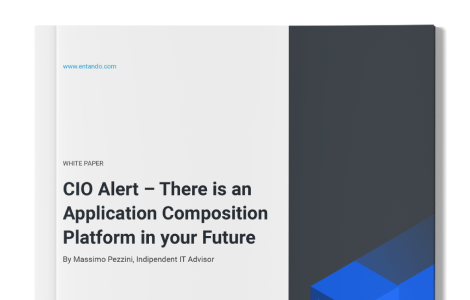
More innovation, lower costs: the power of an Application Composition Platform
For every kind of business, today’s market is highly pressured. Getting the competitive edge doesn’t just mean constantly innovating, but innovating first, fast and cost-effectively. Creating best-in-class apps that help your business thrive is a perpetual priority—and this is only likely to intensify in the next few years.
No surprise, then, that the composable market continues to grow. Gartner estimates that the top 20 cloud platform providers will offer component marketplaces by 2026. The future of enterprise applications is fully modular, endlessly flexible, and highly customised.
But what can an Application Composition Platform do for you? What are the biggest benefits you can expect? And, if you’re not already paying attention to the world of composable apps, what are you missing out on?
The surprisingly long History of software composition
It’s 1968. The Cold War continues, Apollo 8 successfully orbits the moon, and a couple of friends decide to start a small business called Intel. Meanwhile, in the halls of NATO, Malcolm Douglas McIlroy proposes a future where software is made from components that can be repurposed—and sets in motion a vision for technology that is only now in the 2020s coming to fruition.
McIlroy’s idea was simple: software should be made from individual, interoperable building blocks, enabling the mass production of new applications without everyone trying to solve the same basic problems.
In the decades that have followed from 1968, we’ve seen software become instrumental to enterprises and move from cramped on-premise data centres to the cloud. The pressure to innovate new applications has intensified to become a vital part of how enterprises enable their employees to stay productive and deliver ever-improving experiences for their customers.
At the same time, the way software is deployed has changed—first through virtualization and, more recently, through self-contained, containerized deployments that can be run from anywhere. This has led to the emergence of new technology like Kubernetes, a way to manage containerized software, services and resources. But while developing on Kubernetes offers significant improvements to resilience and scalability, organisations need flexible, agile ways to bring applications to life.
In this context, software as the product composed of flexible building blocks is an idea that’s gaining significant momentum.
The key benefits of composable applications
An Application Composition Platform (ACP) for Kubernetes gives you a way to rapidly develop cloud-native applications from self-contained collections of components. As a result, future-thinking businesses can stay ahead of the innovation curve, benefit from deeper code sharing, and move faster to support new capabilities.
#1 Increased agility
When it comes to applications, enterprises have two choices: the slow, often labour-intensive process of coding from scratch or using poorly-fitting software that already exists. Using an ACP lets you create and adapt applications faster, bringing components together to create cloud-native software around the capabilities you need. If using existing software is following a script someone else has written—and coding from scratch is inventing an entire language—using an ACP gives you the power of improvisation.
#2 Faster innovation
An ACP means you can experiment, innovate, and iterate as fast as you need to—and as fast as the market demands. From new front-end experiences to adjustments as your strategic priorities change, an ACP enables you to keep up with whatever your teams need. And with more seamless sharing of similar components across teams and projects, everyone can benefit from any and all development, right across your enterprise.
#3 Reduced costs
While Kubernetes has the potential to reduce costs in its own right, an ACP like Entando lowers the cost of life for your applications. Initial implementation is naturally streamlined with reusable functional and frontend building blocks, reducing development and application maintenance costs and accelerating time to create value. Meanwhile, quality can be standardised, reducing the inevitable technology debt of sub-optimal development and the associated ‘interest’ of bug fixing and costly maintenance. Finally, Entando makes it easier to track, manage, support, secure and govern individual assets and composable applications, reducing the ongoing costs that eat into your return on investment.
#4 Low learning curve
An effective ACP’s use,enables teams to get started without learning or refreshing their knowledge of a given software language. At the same time, new applications can be started from a minimum viable product, so your teams can hit the ground running, iterate over time if needed, and significantly accelerate your organisation’s time to reap value from you’re the team’s applications development and deployment.
Book your personalised Entando demo
Entando is an open source Application Composition Platform (ACP), enabling enterprises to thrive in the Capability Economy. Built on Kubernetes, Entando helps businesses address time-to-market pressure, simplify complex development processes, manage applications efficiently, and scale effortlessly.
See how with a personalised Entando demo, led by our enterprise application specialists.
[ Book a demo ]
